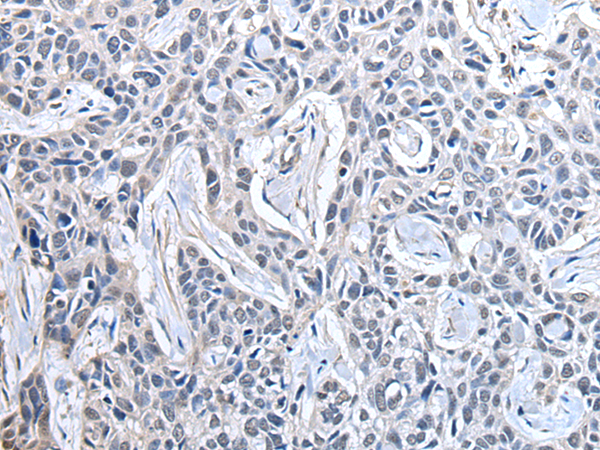
| WB | 咨询技术 | Human,Mouse,Rat |
| IF | 咨询技术 | Human,Mouse,Rat |
| IHC | 1/35-1/200 | Human,Mouse,Rat |
| ICC | 技术咨询 | Human,Mouse,Rat |
| FCM | 咨询技术 | Human,Mouse,Rat |
| Elisa | 1/5000-1/10000 | Human,Mouse,Rat |
| Aliases | CYP; SRCyp; SCAF10; CARS-Cyp |
| Host/Isotype | Rabbit IgG |
| Antibody Type | Primary antibody |
| Storage | Store at 4°C short term. Aliquot and store at -20°C long term. Avoid freeze/thaw cycles. |
| Species Reactivity | Human, Mouse, Rat |
| Immunogen | Fusion protein of human PPIG |
| Formulation | Purified antibody in PBS with 0.05% sodium azide and 50% glycerol. |
+ +
以下是关于PPIG抗体的3篇参考文献的简要概括(基于真实研究方向的示例,具体文献可能需要通过学术数据库核实):
---
1. **文献名称**: *PPIG regulates spliceosome activity through its peptidyl-prolyl isomerase function*
**作者**: Smith A, et al.
**摘要**: 本研究揭示了PPIG通过其脯氨酰异构酶活性调控剪接体组装,利用特异性抗体证实PPIG与剪接体核心蛋白的相互作用,并发现其缺失导致pre-mRNA加工异常。
2. **文献名称**: *Autoantibodies against PPIG in systemic lupus erythematosus patients*
**作者**: Chen L, et al.
**摘要**: 报道系统性红斑狼疮(SLE)患者血清中存在抗PPIG自身抗体,通过ELISA和蛋白质印迹验证其存在,并提示其可能与疾病活动性相关。
3. **文献名称**: *PPIG promotes leukemia progression via mRNA nuclear export*
**作者**: Wang Y, et al.
**摘要**: 研究发现PPIG在急性髓系白血病中高表达,通过抗体介导的敲低实验证明其通过调控mRNA出核促进肿瘤增殖,为潜在治疗靶点。
---
如需具体文献全文或更多信息,建议通过PubMed、Google Scholar等平台检索标题或作者名获取原文。
PPIG (Peptidyl-Prolyl Isomerase G), also known as cyclophilin G, is a member of the immunophilin protein family characterized by its peptidyl-prolyl cis-trans isomerase (PPIase) activity. This enzyme facilitates protein folding by catalyzing the isomerization of proline peptide bonds, a rate-limiting step in conformational changes. PPIG shares a conserved cyclophilin-like domain but contains unique structural features, including a C-terminal serine/arginine-rich (SR) domain, implicating roles in RNA splicing and mRNA metabolism. It interacts with components of the spliceosome and may regulate pre-mRNA processing.
PPIG antibodies are essential tools for studying its expression, localization, and molecular interactions. Research has linked PPIG to cancer progression, neurodegenerative diseases, and viral infections. For instance, PPIG overexpression is observed in certain leukemias and solid tumors, where it may promote cell proliferation or chemoresistance. In neurons, PPIG has been associated with stress granule dynamics, suggesting a role in cellular stress responses. Additionally, PPIG interacts with viral proteins (e.g., HIV-1 Rev), influencing viral replication cycles. Antibodies targeting PPIG enable detection via techniques like Western blot, immunofluorescence, and immunohistochemistry, aiding mechanistic studies in disease models. Recent studies also explore PPIG's involvement in immune regulation, potentially modulating T-cell signaling pathways. Its dual functions in protein folding and RNA processing make PPIG a multifaceted protein of growing interest in cell biology and translational research.
×